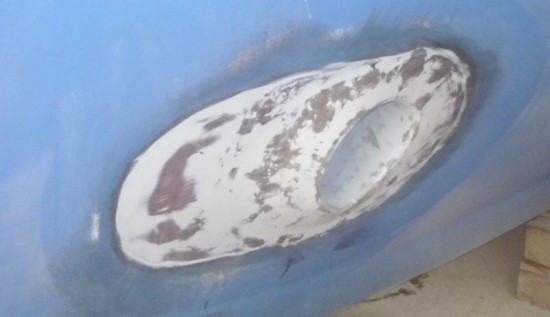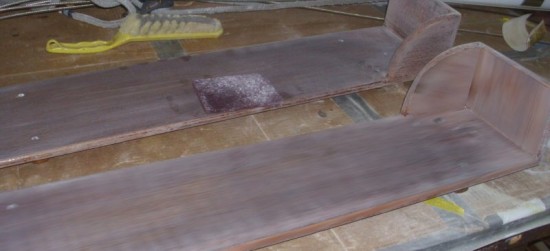 It seems I am wrong a LOT of the time since I am obviously here despite what I said yesterday. We are getting ready to experience some real cold but only for a couple days and man is it windy out there today! We did have to brave the wind and get the EB38 back out of the water after a successful sea trial. This also means we have scramble to round up enough anti-freeze to winterize the boat again. Oh, what we’ll go through to sell a boat!
I don’t have much to offer up today. Pat is in the middle of a big electronics install but right now is pulling out old equipment – nothing I need to show photos of. One guy was out on the sea trial yesterday so nothing for him. Kevin was finishing up the bow thruster tube and I do have a photo of the tube all faired in and ready for epoxy coating.
It seems I am wrong a LOT of the time since I am obviously here despite what I said yesterday. We are getting ready to experience some real cold but only for a couple days and man is it windy out there today! We did have to brave the wind and get the EB38 back out of the water after a successful sea trial. This also means we have scramble to round up enough anti-freeze to winterize the boat again. Oh, what we’ll go through to sell a boat!
I don’t have much to offer up today. Pat is in the middle of a big electronics install but right now is pulling out old equipment – nothing I need to show photos of. One guy was out on the sea trial yesterday so nothing for him. Kevin was finishing up the bow thruster tube and I do have a photo of the tube all faired in and ready for epoxy coating.
We now have 2 coats of sealer and 2 coats of thinned varnish on the name boards – counting as basically one coat on the name boards. I would usually get at least this build before flattening with some 220 grit on a block. Then a good scuffing with a Scotchbrite pad will ensure a good adhesion with the next coat. The object is to fill all the grain that was not taken out when the bare board sanding was done. You can get a faster build by hot-coating but you need some experience to pull this off without creating a mess.
Yachtworld
Yachtworld has firmly entrenched itself into the boat brokerage game to the point where you can hardly sell a boat without being a member. The costs keep escalating and someone is making a helluva lot more money than if they were actually selling boats. They now want to sell (rent) members an app to link to Facebook. I haven’t investigated the cost yet – we pay them enough at this point. I’m not even sure it would even work. Maybe you can help:
[poll id='1']
Anything Can Happen Friday
In follow up to post on varnishing the nameboards, I found these varnishing tips on-line:
- Apply varnish by brush, roller, or spray, six coats minimum on new wood, two coat minimum over old varnish.
- Sand between coats with 220-320 grit sandpaper
- Don’t shake or stir a varnish. It creates bubbles and froth.
- Pour varnish through a paper strainer into another clean container for use, then tightly close the varnish can.
- Store varnish can upside down to ensure a good seal.
- When applying oil-based varnishes, se a tack rag to remove static dust for the cleanest possible surface just before applying varnish. Apply in as dust free area as possible.
- Use a good brush and be sure the brush is clean. This can’t be overstressed. A high-quality natural bristle brush should be used when applying oil-based varnishes and a high-quality nylon, nylon/polyester, or foam brush should be used for water-based varnish application. Foam brushes are also practical for small jobs. Use a comb to remove dust and bits of varnish from the bristles before dipping the brush into the varnish.
- If the bubbles are forming in the varnish during application, many times they can be eliminated by changing the type of brush being used.
- Always brush into the wet edge. That is, don’t start a fresh brush out of varnish from the previous brush load, but rather brush into the previous brush load. That will eliminate brush marks and overlaps.
- Avoid applying varnish in direct sunlight, or late in the day if night time dew is expected.
 Kindle follow up – Thanks to the customer who bought the Kindle and the one who bought the History of Dickerson. I actually created that Kindle book for the Dickerson Owners Group – maybe I can have a new skillset creating Kindle books. I also installed the “Kindle This” plug-in for this blog. Not sure how it works yet as I don’t have my Kindle with me. I plan on trying tonight to see what I get.
Kindle follow up – Thanks to the customer who bought the Kindle and the one who bought the History of Dickerson. I actually created that Kindle book for the Dickerson Owners Group – maybe I can have a new skillset creating Kindle books. I also installed the “Kindle This” plug-in for this blog. Not sure how it works yet as I don’t have my Kindle with me. I plan on trying tonight to see what I get. 


